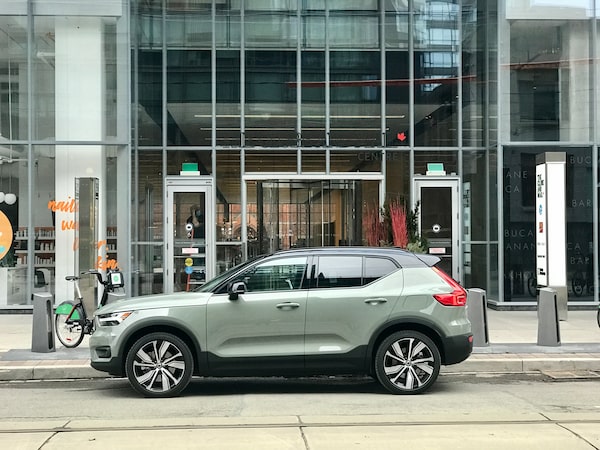
The 2021 Volvo XC40 Recharge.Mark Richardson/The Globe and Mail
If you step inside Volvo’s all-new XC40 Recharge, as I did for an hour this week, you may not realize it’s a fully electric vehicle until you put it in gear. Or, more correctly, engage it to Drive, since EVs don’t have conventional gears like most gas-powered cars.
The compact SUV is the first Volvo to carry the Swedish maker’s Recharge name, which it says it will apply to five new vehicles within the next five years. By 2025, Volvo expects half of all its global sales of passenger vehicles to be fully electric, with the rest being hybrids.
The XC40 won’t be sold in Canada as a plug-in hybrid, however. “Our focus in this market is for the fully electric car,” says Stefan Diklich, product planning and electrification specialist for Volvo Car Canada. “The plug-in hybrid only comes as a front-wheel drive, and Canadians, with our winter, we prefer to have all-wheel-drive SUVs.”
There are some obvious visual differences to the conventional SUV, of course. The grille is solid because the motors don’t need the air-cooling of a regular engine. Underneath the hood is a shallow front trunk, a “frunk” in Porsche-speak, that’s basically large enough to store the recharging cable or a small back pack. The refuelling cap is on the left side and covers a CCS charging socket. The wheels are a little more aerodynamic, and there are some discreet badges that say “Recharge,” and that’s about it. Passenger and cargo space is the same as other XC40s.
There is no ignition switch or even Start button for the Recharge. Like a Tesla, it senses the pressure of you sitting on the driver’s seat to activate the car’s power. Just slide the short shift lever down to Drive or Reverse, and you’re off. And you’re off very quickly if you step hard on the throttle; Volvo claims acceleration from standstill to 100 km/h in 4.9 seconds. That’s much swifter than the 6.4 seconds of the conventional XC40 T5.
It drives very differently because the twin motors of the all-electric Recharge, one for each axle, produce 402 horsepower, compared to the 248 hp of the XC40. They also produce a whopping 486 lb.-ft. of torque, which is enough for a tow rating of 2,000 lbs. (907 kg). My average consumption of electricity during my hour of squirting the car through traffic on both city streets and the highway was 30.1 kWh/100 km.
However, the Recharge is built on the exact same platform as the regular XC40, which was designed from the beginning to accommodate both an internal-combustion engine or a pair of battery-powered electric motors. It has a different construction under the skin to provide specific crumple-zone protection, and there is also a safety cage to protect the integrity of its battery, which is held beneath the entire floor for a low centre of gravity, in a collision.
The popular XC40 is Volvo’s least-expensive vehicle, with a base price of $39,950 plus $2,015 for freight and PDI. The Recharge EV will list for $64,950, though its high-quality standard features make it the equivalent of the $48,250 R-Design trim level. At that price, it’s too costly to qualify for any existing federal or provincial rebates, but Diklich says Volvo hopes to sell “several hundred” Recharges across Canada in 2021, starting in January.
The XC40 Recharge has an official Canadian range of 335 kilometres. That’s playing it safe, as Volvo is known for, because its official European WLTP rating. which uses different testing patterns, is 400-to-418 km. This is close to the long-distance claims of the Tesla Model 3, Nissan Leaf, Chevrolet Bolt and others.
When the weather is warm, its 78 kWh battery (75 kWh useable) will charge to 80 per cent in 40 minutes if it’s plugged into a 150 KW fast charger. Again, this is similar to its leading-edge competition. Volvo is proud that it uses blockchain technology to trace the sources of the cobalt in its batteries, to ensure it is supplied both ethically and responsibly. Cobalt can be sourced in some developing countries with little concern for its impact on miners’ health or the environment.

The Recharge features a few visual details that set it apart from the standard XC40.Mark Richardson/The Globe and Mail
It goes without saying that the Recharge is fully connected, and Volvo has a partnership with Google to power its infotainment system using Android. This means the driver just has to say a request, as he or she would do with a Google Home system, and the car will recognize it. Google Maps is available on the large central touch screen and will keep a running update if needed of the location of local charge points and the power needed to get there.
The Recharge can also download larger software and operating system updates over the air, similar to a Tesla, so it is kept up-to-date without needing to visit a service centre. Almost all of Canada’s 36 Volvo dealers can currently sell and service the Recharge, with the remaining dealers working quickly toward certification.
Tech specs
- Base price/As tested: $64,950 / $71,200, plus $2,015 Freight and PDI
- Engine/Drive: Twin electric motors / AWD
- Battery/Charger: 78 kWh battery / 11kW on-board charger
- Alternatives: Tesla Model Y, Audi e-Tron, Jaguar I-Pace
Shopping for a new car? Check out the Globe Drive Build and Price Tool to see the latest discounts, rebates and rates on new cars, trucks and SUVs. Click here to get your price.
Stay on top of all our Drive stories. We have a Drive newsletter covering car reviews, innovative new cars and the ups and downs of everyday driving. Sign up for the weekly Drive newsletter, delivered to your inbox for free. Follow us on Instagram, @globedrive.
 Mark Richardson
Mark Richardson